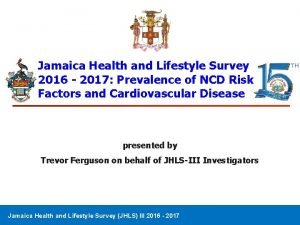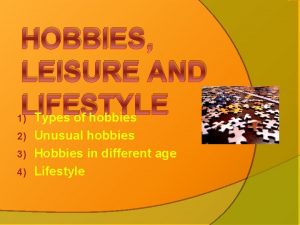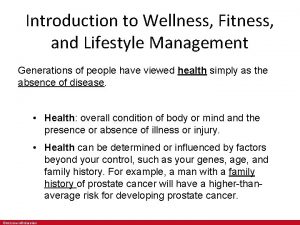Selftracking and Persuasive e Coaching in Healthy Lifestyle
















- Slides: 16

Self-tracking and Persuasive e. Coaching in Healthy Lifestyle Interventions: Work-in-progress Scoping Review of Key Components. Aniek Lentferink, Hilbrand Oldenhuis, Olga Kulyk, Martijn de Groot, Louis Polstra, Hugo Velthuijsen, Hermie Hermens, Lisette van Gemert-Pijnen BCSS Workshop: Epic for Change, the Pillars for Persuasive Technology for Smart Societies Persuasive Technology 2016, April 5 th, Salzburg

Outline • • • Intro and new approach Self-tracking & Persuasive e. Coaching Scoping review methodology Preliminary results Limitations and future research

Intro and new approach • Unhealthy lifestyle worldwide problem • New approach: Self-tracking & Persuasive e. Coaching

Self-tracking & persuasive e. Coaching • In line with the new WHO-definition of health: “…the ability to adapt and cope…” (Huber et al. , 2011) • We define persuasive e. Coaching as: The remote and automatic provision of just-in-time tailored feedback for healthy lifestyle management, by enabling users to set personal goals and encouraging to track personal progress towards their goals, adapting the feedback to the usage patterns and context, and encouraging long-term use.

Self-tracking & persuasive e. Coaching Possibilities Challenges Scalability Privacy Sustainability Just-in-time tailore feedback Trust to Objective insight in rn tte lifestyle pa Ethics d

Research question “What are key components of (in)effective healthy lifestyle interventions using self-tracking and persuasive e. Coaching? ”

Scoping review methodology • York methodological framework (Arksey and O’Malley, 2005). • Databases: Pubmed, EMBASE, Psyc. INFO, and Scopus • Effectiveness intervention: – More effective: + majority of outcomes +/- comparison interventions + waiting lists/no intervention – Less effective: + minority of outcomes +/-, - comparison interventions + waiting lists/no intervention – Ineffective: - outcomes - waiting lists/no intervention Full search: 297 publications Title selection: 181 publications Abstract selection: 73 publications Preliminairy scoping review: 7 publications

Preliminary results – Self-tracking • Effort by participant to obtain objective data: Most effort in more effective interventions • Duration self-tracking: Long-term (>3 months) self-tracking in less and more effective interventions

Results (2) – Persuasive e. Coaching components More effective Less effective Ineffective Expertise (n=2) Personalization Praise (n=2) Reduction (n=2) Reminders Rewards Suggestion Tailoring (n=2) Tunneling Personalization Praise Suggestion Tailoring Normative influence Personalization (n=2) Reminders (n=1) Similarity Social role Suggestion (n=3) Tailoring (n=2) Tunneling Categorization components: Persuasive System Design Model (Oinas-Kukkonen and Harjumaa, 2009)

Results (2) – Persuasive e. Coaching components More effective Less effective Ineffective Expertise (n=2) Personalization Praise (n=2) Reduction (n=2) Reminders Rewards Suggestion Tailoring (n=2) Tunneling Personalization Praise Suggestion Tailoring Normative influence Personalization (n=2) Reminders (n=1) Similarity Social role Suggestion (n=3) Tailoring (n=2) Tunneling Categorization components: Persuasive System Design Model (Oinas-Kukkonen and Harjumaa, 2009)

Results (2) – Persuasive e. Coaching components More effective Less effective Ineffective Expertise (n=2) Personalization Praise (n=2) Reduction (n=2) Reminders Rewards Suggestion Tailoring (n=2) Tunneling Personalization Praise Suggestion Tailoring Normative influence Personalization (n=2) Reminders (n=1) Similarity Social role Suggestion (n=3) Tailoring (n=2) Tunneling Categorization components: Persuasive System Design Model (Oinas-Kukkonen and Harjumaa, 2009)

Results (2) – Persuasive e. Coaching components More effective Less effective Ineffective Expertise (n=2) Personalization Praise (n=2) Reduction (n=2) Reminders Rewards Suggestion Tailoring (n=2) Tunneling Personalization Praise Suggestion Tailoring Normative influence Personalization (n=2) Reminders (n=1) Similarity Social role Suggestion (n=3) Tailoring (n=2) Tunneling Categorization components: Persuasive System Design Model (Oinas-Kukkonen and Harjumaa, 2009)

Preliminary results (3) – Main theme’s Usability: • Acceptable messages per day Adherence: • Good adherence to self-tracking • Reasons non-adherence: design aesthetics dependent on content • Privacy issues not a burden for every group of users

Limitations and Future research Limitations: • Few publications included • • Data extraction based on content of publication Separate components and effectiveness Future research: • Demonstrated added value of needs assessment • Privacy issues important field of research

Lessons learned for EPIC Engagement/Empathy: o o o Expertise Praise Reduction Personalization: o Number of messages dependent on content Integration/Implementation: o o o Effort by participant not an issue when in balance with added value Aesthetics Long-term self-tracking Connectivity: Change: o Differences between groups of users

Self-tracking and Persuasive e. Coaching in Healthy Lifestyle Interventions: Work-in-progress Scoping Review of Key Components. Thanks for your attention and please share your thoughts with me. Aniek Lentferink Ph. D researcher and lecturer a. j. lentferink@pl. hanze. nl
 Healthy lifestyle wrap up lecture
Healthy lifestyle wrap up lecture Healthy lifestyle sentences
Healthy lifestyle sentences Moodboard healthy lifestyle
Moodboard healthy lifestyle Doh health programs
Doh health programs Healthy food healthy mind journal
Healthy food healthy mind journal Healthy soil healthy life poster ideas
Healthy soil healthy life poster ideas Healthy community poster
Healthy community poster Healthy nurse healthy nation
Healthy nurse healthy nation Lifestyle modern
Lifestyle modern Jamaica health and lifestyle survey
Jamaica health and lifestyle survey Lifestyle hobbies
Lifestyle hobbies Fashion and lifestyle logistics
Fashion and lifestyle logistics Reaching wellness through lifestyle management
Reaching wellness through lifestyle management Wellness and lifestyle management
Wellness and lifestyle management Self concept and lifestyle
Self concept and lifestyle Exercise health and lifestyle
Exercise health and lifestyle Lifestyle of sparta
Lifestyle of sparta































